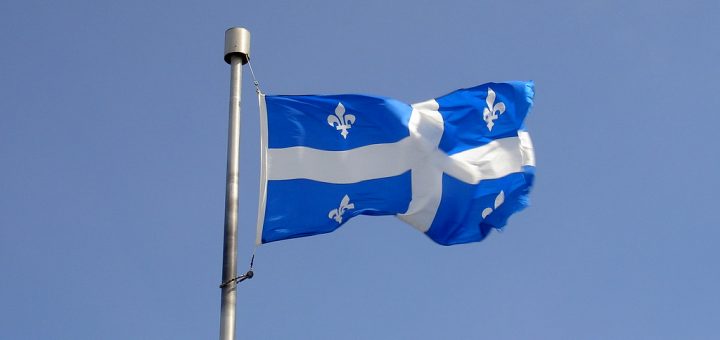Quebec’s Religious Neutrality Bill: What a Leave to Appeal Could Mean for Bill 21

Is the restriction of religious garments worn by public servants an infringement of constitutionally guaranteed freedom of religion that cannot be justified or is this is a restriction necessitated by true state neutrality? In the past few years, this question has bounced between constitutional law scholars, political pundits and even candidates in the federal election.
Bill 21, passed in the Quebec legislature in 2019, restricted the ability of public servants in the province of Quebec to wear symbols of faith while working in public facing roles. The use of the notwithstanding clause immunizes the Bill from Charter challenges on freedom of religion grounds, so the current ongoing constitutional challenge to the Bill is taking more a more innovative route. This includes arguments that the Bill is actually criminal legislation, thereby placing it outside provincial jurisdiction, and that it violates section 28 of the Charter, as the gender equality provision not covered by the notwithstanding clause.
Following multiple challenges to the Bill and two lower court decisions denying an application for a stay, one of the central parties involved in the case have sought leave to appeal to the recent Court of Appeal decision to the Supreme Court of Canada (SCC). On the heels of this announcement, this post explores how the claimants are hoping to get around the notwithstanding clause and what it could mean for the future of Bill 21 if leave to appeal is granted and the issue reaches the bench.
Background
In March of 2019, the Québec government introduced Bill 21, the “religious neutrality” legislation that would bar both those receiving public services and those providing them from “wearing religious symbols while exercising their functions” (An Act respecting the laicity of the State, SQ 2019, c 12, s 15) [Bill 21]. Importantly, to protect itself from what many believed to be an inevitable Charter challenge of the Act, the government invoked section 33 of the Charter, the Notwithstanding clause, exempting it from interference from sections 2(a) (freedom of religion), 15 (the equality provisions) and 7 (life, liberty and security of the person).
The Act officially came into effect on June 16. It had barely been in effect for 24 hours when the National Council of Canadian Muslims (NCCM), the Canadian Civil Liberties Association (CCLA) and a sole claimant, Ichrak Hak, filed a constitutional challenge and an application to suspend its operation. The Quebec Superior Court (QCCS) denied the application in Hak v Attorney General of Quebec, 2019 QCCS 2989, [Hak QCCS]. The Quebec Court of Appeal (QCCA) released decisions upholding the lower court decision, 2019 QCCA 2145 [Hak QCCA]. A few days later, the CCLA announced in a press release that it would be seeking leave to appeal to the SCC.
This legal battle has transpired against the backdrop of a highly public debate. With civil liberties groups presenting evidence that Bill 21 disproportionately bars Muslim women wearing the hijab or other Islamic attire from full access to public life, central organizations such as the National Council of Canadian Muslims (NCCM) have labeled it a flagship of Canadian Islamophobia. Advocacy surrounding the case has featured narratives by individuals affected, many of whom argue that the Bill allows Sikhs wearing turbans, Jewish people wearing the kippah and Muslims to be treated as second-class citizens. The Bill’s proponents, however, argue that a certain amount of restriction of overt religious symbols is necessary to achieve the aims of true state secularism.
The Quebec courts’ decisions mainly concern the preliminary issue of whether to grant a stay of the Bill, pending a review of the merits. This requires a consideration of the potential harm to the public interest that would occur if the stay were denied. The harm articulated by the claimants in directly relates to the Bill’s immediate and widespread restriction of religious practice across the province. Therefore, while the merits of the challenge are not yet being directly considered, the stay application as a preliminary matter still calls forth many questions about rights to religious freedom.
The Quebec Superior Court Decision
In considering only the preliminary question of the application for a stay, the Court begins its analysis of whether the stay should be granted with the government’s invocation of the notwithstanding clause. The claimants’ argue that the use of the notwithstanding clause does not preclude all constitutional arguments, such as those based in provisions beyond the ones stipulated or those surrounding unwritten constitutional principles (Hak QCCS, para 48). Therefore, the three arguments they pose in requesting a stay of the Act are constitutional: that the Act is ultra vires the Quebec legislature and is a matter of federal authority because its pith and substance is related to criminal law, that it is too vague in its application and therefore contravenes the rule of law principle, and that it violates the inherent “Constitutional architecture” and “unwritten constitutional principles of democracy and the protection of minorities” by sequestering those belonging to religious minority groups from participating in the full range of public life (paras 49-52; CCLA, Application for an Interim Stay, paras 13-14).
The Court considers each of these arguments under the first branch of the criteria for granting an interim stay laid out in RJR-MacDonald, [1994] 1 SCR 311. Firstly, in a constitutional matter, the applicant must establish that the appeal raises a serious issue that is neither “frivolous or vexatious” (RJR-MacDonald, 314). Secondly, it must be demonstrated that the denial of the stay would cause irreparable harm (315). Lastly, there must be a general analysis of the balance of inconvenience, with overarching consideration to the public interest (315).
Under the first factor, considering the applicants’ three central arguments for requesting a stay, the Court addresses the question of whether the first constitutional argument concerning the division of powers is a matter that is sufficiently serious under the first RJR-MacDonald factor. While the Court is hesitant to grant weight to the second argument regarding the rule of law and the Act’s alleged vagueness, stating that such an invalidity passed by the legislature “in the name of a constitutional principle is always a daring gamble” (Hak QCCS, para 81), the first and last arguments — the Act’s potential violation of the division of powers and of the architecture of the Constitution — together generate a seriousness that is sufficient to meet the first RJR-MacDonald criteria.
Under the second criteria, the consideration of any irreparable harm that would be caused by the denial of interim relief, the Court provided an overview of a series of affidavits by individuals and members of organizations closely connected to the Act’s impact, including members of the NCCM, claimant Ichrak Hak, and teachers who would have to remove their religious attire to continue their work. The statements each express the extent to which the Act would impact to be fully integrated into Quebec society and continue their career aspirations as members of religious minorities in the province, such as an ability to be hired in the public service, to be promoted, and the disproportionate effect of disciplinary measures against those wearing religious attire. Regardless, the Superior Court finds that the many of the statements “are purely hypothetical and often speculative” and, therefore, the applicants “failed to demonstrate … serious or irreparable damage at the stage of the application for an interim interlocutory injunction” (para 116). The violation of any of the rights and freedoms codified by the Charter provisions stipulated under the notwithstanding clause cannot be considered irreparable harm under these circumstances (para 125).
This, in conjunction with the third criteria of an overall balance of inconvenience analysis, led the Superior Court to conclude that defeating a law that was clearly enacted for the “common good” in the protection of “individual interests, however noble the intention behind the approach, requires a decision on merit and not in a preliminary manner” (para 143). The Superior Court denied the application for a stay.
The Quebec Court of Appeal Decision
On appeal, the QCCA accepted new evidence in the form of additional affidavits prepared by witnesses affected by the Act. Significantly, the Court also considered whether it can, at the appeal level, include a new question for consideration: whether the notwithstanding clause affects the ability of the Court to consider a possible violation of section 28 of the Charter, which codifies the equal guarantee of rights and freedom between men and women, and which the claimants argue is violated by the Act’s disproportionately bars women from public services. The Court agreed that the principle codified by section 28 is immediately relevant to both the analysis of the Act’s constitutional validity and the application for a stay. Considering the history of section 28 and the notwithstanding clause, the Court concluded that the new question is “relevant and admissible for the purposes of this appeal” (Hak QCCA, para 55).
At the time of this appeal was heard, the affidavits of the claimants and witnesses were no longer “hypothetical” or “speculative”, because the Act had been operating and had barred people from being hired or moving forward in their jobs due to their religious attire. Specifically considering the Act’s impact on Muslim women, the Court agrees that there is an “immediate violation of the equality rights of female teachers wearing the Islamic headscarf” (para 60, emphasis in original).
Considering again the RJR-MacDonald factors, all three judges agreed that the change in circumstances in the Act’s effects and the additional affidavits indicate that the risk of irreparable harm under the second factor has been actualized. However, two of the three judges were swayed by the weight of the notwithstanding clause. Unless it is clear that the law is invalid, the invocation of the notwithstanding clause requires that the Court must refuse the stay, even if there are serious constitutional questions raised (para 97). Emphasizing the preliminary nature of this stage, the Court hesitates to suspend the Act’s application on these grounds until the constitutional question underlying the challenge are heard.
Seeking Leave to Appeal
Last week, the CCLA announced that alongside the NCCM and the claimant, Ichrak Hak, it would be seeking leave to appeal the QCCA decision to the SCC on an expedited basis, on the issue of the application for a stay. Mustafa Farooq, Executive Director of the NCCM, stated that “while teachers and other public sector workers are being forced out of their jobs, we will seek leave from the SCC to halt the serious and irreparable harm that Bill 21 causes.”
The above decisions and the claimants’ reasons for requesting a stay are intimately linked to evidence of curtailed religious freedom and, in turn, to the ideas that underly and occupy religious freedom, even if not based in the religious freedom provision itself. Therefore, it may be that the Supreme Court’s potential consideration of the stay application provides an exploration of the central constitutional issues underlying the case. Such a decision — which would balance questions of gender implicated by section 28 against questions of religious practice within the boundaries of the notwithstanding clause — could have national implications for the interpretation of religious practice and the ability for governments to justify its curtailment, particularly when exercising such a clear exemption from Charter-protected rights and freedoms. It could also create an opportunity for the Court to opine on how the notwithstanding clause can be invoked.
The Act’s effects, on their face, clearly create restrictions on religious freedom. But the notwithstanding clause complicates the route through which the claimants can effectively present their case. With the lower courts consistently attaching their decisions to the weight of the notwithstanding clause and viewing the argument regarding unwritten constitutional principles less than favourably, this will be particularly pertinent if their arguments appear before the SCC. However, the area of this particular preliminary issue with the most power in the event of a leave to appeal is the factor of irreparable harm.
If the SCC grants leave to appeal, the Justices may have to balance between two significant notions: firstly, the corroborated and consistently widening evidence of the irreparable harm inflicted disproportionately on Muslim women by the Act and, secondly, the constitutional primacy of the notwithstanding clause and the resolute power that it invokes. And regardless of where the Court stands on the notwithstanding clause, it is likely that an analysis of the former will necessitate a careful consideration of the evidence: stories of those most affected, largely Muslim and largely women, whose careers, aspirations and sense of belongingness in Québec culture are permanently halted by the Act’s effect.
The tension between the manner with which some choose to practice their religion and the extent to which these practices can be confined may still be a central aspect of a potential SCC decision on the issue, regardless of the existence of a notwithstanding clause and regardless of it being a question of interim relief. It may be that the SCC seizes the opportunity to grant clarity to an essential question beneath the Act and the legal discourse around it: what does it mean for a state to validly impose “religious neutrality”? Is true neutrality in the freedom from overt religious symbols and signs of diverse religious practice, as framers and proponents of the Bill may argue? Or is it in the neutral and even actions of the state towards religious practice, regardless of how belief is expressed? And if the latter is true, is Bill 21 failing its neutral aims?
Conclusion
The underlying constitutional questions of this case have sparked public protests and nation-wide activism. And although it seems the crux of constitutional challenge is yet to be heard on its merits, the application for a stay of the Act has already garnered decisions that are intimately connected to principles codified by the Charter, particularly for those women disproportionately caught by its net. If a leave to appeal to granted, these issues could reverberate across various legal branches: how the notwithstanding clause can limit the ability to grant a stay, how the criteria for granting a stay must be considered in cases of religious practice, and, perhaps most pertinently, how the principles underlying freedom of religion influence the analysis of a law that exempts itself from criticism under the freedom of religion Charter provision.







Join the conversation